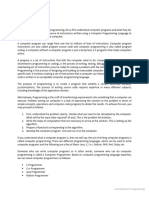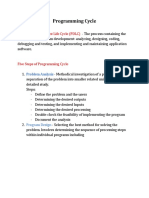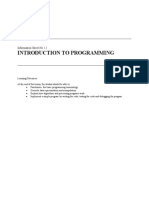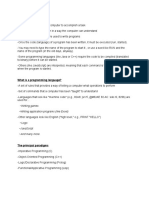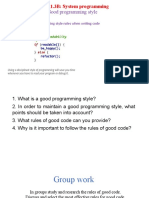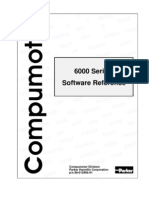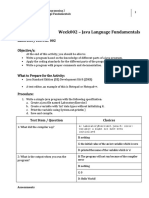Programming Fundamentals - Basics
Introduction to Programming
Programming is the process of creating a set of instructions that tell a computer how to perform a
task. It involves writing, testing, and maintaining code. In this chapter, we explore why programming
is important, and how it powers everything from simple calculators to advanced AI systems.
�What is an Algorithm?
An algorithm is a step-by-step procedure to solve a problem. Algorithms are the foundation of
programming. For example, a recipe is an algorithm for cooking. Flowcharts are visual
representations of algorithms, helping programmers plan before coding.
�Flowcharts
Flowcharts use shapes like ovals, rectangles, and diamonds to represent processes, decisions, and
inputs/outputs. They make problem-solving easier by visualizing the steps.
�Variables
Variables are like containers that store data. They allow programmers to save information for later
use. For example, int age = 18; stores a number in a variable named age.
�Data Types
Common data types include integers, floating-point numbers, characters, strings, and booleans.
Choosing the correct data type is important for efficiency and accuracy.
�Input and Output
Input is the way users provide data to a program, and output is how the program shows results. For
example, taking a number from a user and printing its square.
�Operators
Operators are special symbols that perform operations on data. Examples: Arithmetic operators (+,
-), Comparison operators (==, !=), and Logical operators (&&, ||).
�Conditional Statements
Conditionals allow decisions in a program. The IF statement checks conditions and executes code
accordingly. Example: if (age >= 18) { print('Adult'); }.
�Loops
Loops allow repetition. Types include: For loop, While loop, and Do-while loop. They reduce
redundancy by running the same code multiple times.
�Switch Statement
Switch is an alternative to multiple IF statements. It checks a variable against several cases,
executing the matching one.
�Functions
Functions are reusable blocks of code that perform a specific task. Example: int add(int a, int b) {
return a+b; }. Functions promote reusability and modularity.
�Parameters and Return Values
Parameters are inputs to functions, and return values are outputs. They make functions flexible and
powerful.
�Scope of Variables
Scope defines where a variable can be accessed. Local variables exist only inside a function, while
global variables exist throughout the program.
�Arrays
Arrays store multiple values of the same type in a single variable. Example: int marks[5] = {90, 85,
88, 92, 75};.
�Strings
Strings are sequences of characters. They can be manipulated with functions like length, substring,
and concatenation.
�Error Handling Basics
Errors are of three types: syntax errors, runtime errors, and logical errors. Debugging is the process
of finding and fixing these errors.
�Comments in Code
Comments are ignored by the compiler but help programmers document their code. Example: //
This is a comment.
�Good Programming Practices
Practices include writing readable code, using meaningful variable names, and keeping functions
short and focused.
�Pseudo Code
Pseudo code is a plain language description of steps in an algorithm. It helps in planning programs
before coding.
�Basic Problem Solving
Problem solving involves understanding the problem, designing an algorithm, implementing it in
code, and testing the solution.
�Introduction to Object-Oriented Concepts
Though advanced, beginners should know about objects, classes, and encapsulation. These
concepts make large programs easier to manage.
�Real-life Programming Examples
Examples: ATM machine logic, online shopping cart, or a simple calculator program.
�Exercises - Variables & Data Types
Practice: Declare 5 variables of different types and print their values.
�Exercises - Conditionals & Loops
Practice: Write a program to print numbers 1 to 100. Modify it to print only even numbers.
�Exercises - Functions
Practice: Write a function that takes two numbers and returns their greatest common divisor (GCD).
�Exercises - Arrays
Practice: Store 10 numbers in an array and print the maximum and minimum values.
�Mini Project - Calculator
Build a simple calculator that performs +, -, *, / operations using conditionals and functions.
�Mini Project - Student Grading System
Create a program that takes student marks, stores them in an array, calculates average, and prints
grades.
�Mini Project - Number Guessing Game
Write a program where the computer generates a random number, and the user guesses until
correct.
�Final Thoughts & Next Steps
Programming fundamentals are just the beginning. Next, you can explore advanced topics like
Object-Oriented Programming, Data Structures, and Algorithms.







